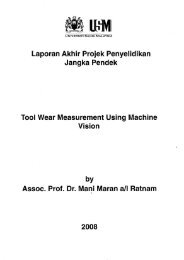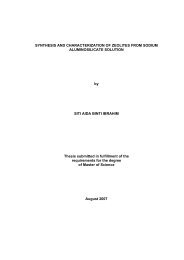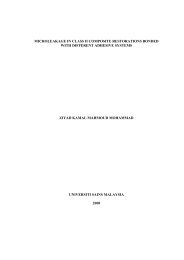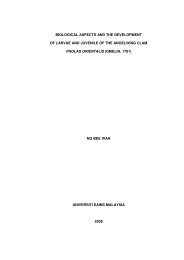[ED04] Process design of hydro-distillation in ginger oil ... - USM
[ED04] Process design of hydro-distillation in ginger oil ... - USM
[ED04] Process design of hydro-distillation in ginger oil ... - USM
Create successful ePaper yourself
Turn your PDF publications into a flip-book with our unique Google optimized e-Paper software.
The 4th Annual Sem<strong>in</strong>ar <strong>of</strong> National Science Fellowship 2004<br />
FIGURE 7 The improved steam <strong>distillation</strong><br />
equipment set up.<br />
The results from this study suggested that<br />
g<strong>in</strong>ger <strong>oil</strong> be extracted by steam <strong>distillation</strong>.<br />
The equipment must be made <strong>of</strong> sta<strong>in</strong>less steel<br />
s<strong>in</strong>ce g<strong>in</strong>ger <strong>oil</strong> consists <strong>of</strong> phenols, which<br />
will react with copper and any other metal<br />
(Figure 7). For larger and fixed <strong>in</strong>stallations,<br />
steam <strong>distillation</strong> is unquestionably <strong>of</strong>fers the<br />
most advantages. Among other advantages <strong>of</strong><br />
extract<strong>in</strong>g g<strong>in</strong>ger <strong>oil</strong> by steam <strong>distillation</strong> are<br />
as follows:<br />
(1) Without heat damage at ambient<br />
temperature throughout.<br />
(2) Without exposure to vacuum<br />
stripp<strong>in</strong>g.<br />
(3) Without loss <strong>of</strong> quality or fragile<br />
components.<br />
(4) Without be<strong>in</strong>g exposed to acidic gases<br />
or oxygen.<br />
(5) Without the need for alcohol<br />
ref<strong>in</strong>ement.<br />
(6) Simple to operate and easy to clean.<br />
(7) Non-hazardous, robust and simple to<br />
ma<strong>in</strong>ta<strong>in</strong>.<br />
(8) Low energy and labour cost.<br />
(9) Less costly than vacuum <strong>distillation</strong>.<br />
G<strong>in</strong>ger <strong>oil</strong> is a type <strong>of</strong> essential <strong>oil</strong> that is<br />
not suitable to be extracted at excess pressure<br />
s<strong>in</strong>ce g<strong>in</strong>ger <strong>oil</strong> decomposed at high<br />
temperature as illustrated by the quality<br />
analysis <strong>of</strong> g<strong>in</strong>ger <strong>oil</strong> <strong>in</strong> the previous<br />
discussion. Therefore, it is much more<br />
practical to be extracted at atmospheric<br />
pressure. In this case, wet steam is used to<br />
distil out the g<strong>in</strong>ger <strong>oil</strong>.<br />
M<strong>in</strong>or improvements were done on the<br />
<strong>design</strong> <strong>of</strong> the equipment currently used <strong>in</strong><br />
Malaysia. In this <strong>design</strong> as shown <strong>in</strong> figure 6,<br />
a heat<strong>in</strong>g c<strong>oil</strong> was used to b<strong>oil</strong> the water <strong>in</strong>side<br />
the vessel. This will allow sufficient heat<br />
supplied <strong>in</strong>to the system without burn<strong>in</strong>g the<br />
sample <strong>in</strong>side it. The height <strong>of</strong> the still<br />
depends on the porosity <strong>of</strong> the plant material.<br />
Plant material can be put on two trays at the<br />
same time as to allow more g<strong>in</strong>ger <strong>oil</strong><br />
recovered. A basket can also replace the trays.<br />
Another different feature <strong>in</strong> this <strong>design</strong> is that<br />
a sight glass was <strong>design</strong>ed on the left side <strong>of</strong><br />
the vessel as shown <strong>in</strong> figure 7 to make sure<br />
there was sufficient amount <strong>of</strong> water for<br />
<strong>distillation</strong> to happen. A gooseneck leads from<br />
the center <strong>of</strong> the spherical top cover to the<br />
condenser. The gooseneck is <strong>design</strong>ed not to<br />
be high, slightly curved and gradually<br />
descend<strong>in</strong>g as to avoid it from act<strong>in</strong>g as a<br />
reflux condenser. A baffle is put at the<br />
open<strong>in</strong>g to the gooseneck as to filter out<br />
particles that might also be evaporated <strong>in</strong> the<br />
process. As a precaution, a safety valve was<br />
also put <strong>in</strong>to the <strong>design</strong>. The still is also well<br />
<strong>in</strong>sulated to conserve heat. This is done to<br />
avoid excess condensation <strong>of</strong> steam with<strong>in</strong> the<br />
still as a result <strong>of</strong> heat losses from its surface.<br />
The bottom <strong>of</strong> the retort is also provided by a<br />
dra<strong>in</strong> valve sufficiently wide enough to<br />
dispense water <strong>in</strong>side the vessel. This dra<strong>in</strong><br />
valve also serves as an outlet for the wash<br />
water, when the still is cleaned.<br />
The condenser used <strong>in</strong> this <strong>design</strong> is a<br />
vertical c<strong>oil</strong> condenser as shown <strong>in</strong> figure 7<br />
that <strong>in</strong> which c<strong>oil</strong>s are <strong>in</strong>serted <strong>in</strong>to a tank<br />
supplied with runn<strong>in</strong>g cold water. The vertical<br />
condenser was chosen s<strong>in</strong>ce it will not take up<br />
a lot <strong>of</strong> space. Long c<strong>oil</strong>s were used so that<br />
less cool<strong>in</strong>g water is needed to make sure that<br />
the contact with the vapours and with the<br />
flow<strong>in</strong>g condensate lasts longer. This will also<br />
permit the absorption <strong>of</strong> more heat, so that at<br />
the end the temperature <strong>of</strong> the condensate will<br />
approach that <strong>of</strong> the <strong>in</strong>flow<strong>in</strong>g cool<strong>in</strong>g water.<br />
The third essential part <strong>of</strong> the equipment is<br />
the <strong>oil</strong> separator. Figure 7 shows the <strong>design</strong> <strong>of</strong><br />
the <strong>oil</strong> separator. The <strong>oil</strong> separator permits the<br />
removal <strong>of</strong> water whether the <strong>oil</strong> be<strong>in</strong>g<br />
distilled is heavier or lighter than water. S<strong>in</strong>ce<br />
the total volume <strong>of</strong> water condensed is always<br />
much more than the quantity <strong>of</strong> <strong>oil</strong>, the water<br />
will be removed cont<strong>in</strong>uously. The separator<br />
was also <strong>design</strong>ed so that water can be<br />
returned <strong>in</strong>to the still and redistilled dur<strong>in</strong>g<br />
<strong>distillation</strong> as shown <strong>in</strong> figure 7.<br />
530


![[ED04] Process design of hydro-distillation in ginger oil ... - USM](https://img.yumpu.com/27762308/4/500x640/ed04-process-design-of-hydro-distillation-in-ginger-oil-usm.jpg)














